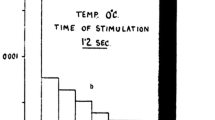Abstract
For a quantitative EMG analysis reliable and unique values of the electrical conductivities of skeletal muscle tissuein vivo are indispensable. Literature values do not satisfy these criteria. In the paper experimental results of conductivity measurements (four-electrode technique) on musclesin vivo on which quantitative EMG experiments are also carried out are reported. Depending on the interelectrode distance (IED) in the four-electrode technique the results appear to be either frequency dependent (IED=0·5 mm) or frequency independent (IED=3·0 mm). The anisotropy value obtained with an IED of 0·5 mm is frequency dependentin the frequency range of EMG signals. Experimental results of different muscle types (white muscle, EDL rat and red muscle, soleus rat) appear to be significantly different.
Similar content being viewed by others
References
Andreassen, S. andRosenfalck, A. (1978) Recording from a single motor unit during strong effort,IEEE Trans.,BME-25, 501–508.
Boyd, D. C., Lawrence, P. D. andBratty, P. J. A. (1978) On modeling the single motor unit action potential.,BME-25, 236–243.
Burger, H. C. andvan Dongen, R. (1960) Specific electric resistance of body tissues,Phys. in Med. & Biol.,5, 431–447.
Clerc, L. (1976) Directional differences of impulse spread in trabecular muscle from mammalian heart.J. Physiol.,225, 335–346.
Dimitrov, G. andDimitrova, N. (1974) Extracellular potential field of a single striated muscle fibre immersed in anisotropic volume conductor.Electromyogr. Clin. Neurophysiol. 14, 423–436.
Epstein, B. R. andFoster, K. R. (1983) Anisotropy in the dielectric properties of skeletal muscle.Med. & Biol. Eng. & Comput.,21, 51–55.
Falk, G. andFatt, P. (1964) Linear electrical properties of striated muscle fibres observed with intracellular electrodes.Proc. R. Soc. London. Ser. B. (Biol. Sci.),160, 69–123.
Gath, I. andStalberg, E. (1975) Frequency and time domain characteristics of single muscle fibre action potentials.Electroenceph. and Clin. Neurophysiol.,39, 371–376.
Geddes, L. A. andBaker, L. E. (1967) The specific resistance of biological material. A compendium of data for the biomedical engineer and physiologist.Med. & Biol. Eng.,5, 271–293.
Gielen, F. L. H. andBoon, K. L. (1981) Measurements on the (complex) electrical conductivity and the anisotropy in skeletal muscle; a new electrode configuration. Proceedings of the Vth International Conference on Electrical Bio-Impedance, August 1981, Tokyo, Japan, 191–194.
Gielen, F. L. H. andBergveld, P. (1982) Comparison of electrode impedances of Pt, PtIr (10% Ir) and Ir-AIROF electrodes used in electrophysiological experiments.Med. & Biol. Eng. & Comput.,20, 77–83.
Gielen, F. L. H. andCruts, H. E. P. (1982) Anatomical structure and electrical conductivity of skeletal muscle tissue. Proceedings of World Congress on Medical Physics and Biomedical Engineering, Hamburg, 2.28.
Gielen, F. L. H. (1983) Electrical conductivity and histological structure of skeletal muscle. Thesis, Twente University of Technology, The Netherlands.
Griep, P. A. M., Boon, K. L. andStegeman, D. F. (1978) A study of the motor unit action potential by means of computer simulation.Biol. Cybernetics,30, 221–230.
Griep, P. A. M., Gielen, F. L. H., Boom, H. B. K., Boon, K. L., Hoogstraten, L. L. W., Pool, C. H. andWallinga-de Jonge, W. (1982) Calculation and registration of the same motor unit action potential.Electroenceph. & Clin. Neurophysiol.,53, 388–404.
Lorente de No, R. (1947) A study of nerve physiology.Studies Rockefeller Inst. Med. Res.,132, 384–477.
Mobley, B. A. andEidt, G. (1982) Transverse impedance of single frog skeletal msucle fibres.Biophys. J.,40, 51–59.
Plonsey, R. andHeppner, D. B. (1967) Considerations of quasistationarity in electrophysiological systems.Bull. Math. Biophys.,29, 657–664.
Plonsey, R. (1969)Bio-electric phenomena. McGraw-Hill, New York.
Plonsey, R. (1977) Action potential sources and their volume conductor fields.Proc. IEEE,65, 601–611.
Plonsey, R. andBarr, R. (1982) The four-electrode resistivity technique as applied to cardiac muscle.IEEE Trans.,BME-29, 541–546.
Robbilard, P. N. andPoussart, D. (1979) Spatial resolution of four electrode array.,BME-26, 465–470.
Rosenfalck, P. (1969) Intra- and extracellular potential fields of active nerve and muscle fibres.Acta Physiol. Scand., Suppl. 321, 1–168.
Rush, S. (1962) Methods of measuring the resistivities of anisotropic conducting mediain situ.J. Res. Nat. Bur. Stand.,66C, 217–222.
Rush, S., Abildskov, J. A. andMcFee, R. (1963) Resistivity of body tissues at low frequencies.Circ. Res.,12, 40–50.
Schwan, H. P. (1968) Electrode polarization impedance and measurements in biological materials.Ann. NY Acad. Sci.,48, 191–209.
van Oosterom, A., de Boer, R. W. andvan Dam, R. Th. (1979) Intramural resistivity of cardiac tissue.Med. & Biol. Eng. & Comput.,17, 337–343.
Wallinga-de Jonge, W., Boom, H. B. K., Boon, K. L., Griep, P. A. M. andLammerée, G. C. (1980) Force development of fast and slow skeletal muscle at different muscle lengths.Am. J. Physiol.,239, C98-C104.
Wani, A. M. andGuha, S. K. (1980) Synthesising of a motor unit potential based on the sequential firing of muscle fibres,Med. & Biol. Eng. & Comput.,18, 719–726.
Weidman, S. (1970) Electrical constants of trabecular muscle from mammalian heart.J. Physiol.,210, 1041–1054.
Author information
Authors and Affiliations
Rights and permissions
About this article
Cite this article
Gielen, F.L.H., Wallinga-de Jonge, W. & Boon, K.L. Electrical conductivity of skeletal muscle tissue: Experimental results from different musclesin vivo . Med. Biol. Eng. Comput. 22, 569–577 (1984). https://doi.org/10.1007/BF02443872
Received:
Accepted:
Issue Date:
DOI: https://doi.org/10.1007/BF02443872




